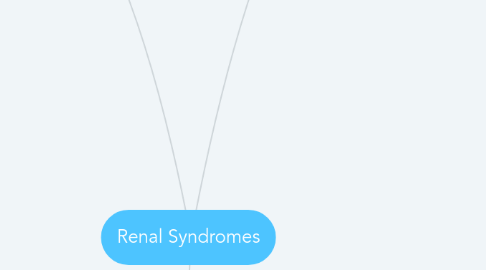
1. Tubular Syndromes
1.1. Noninflammatory tubulointerstitial disease
1.1.1. Pathophysiology
1.1.1.1. Renal Tubule fails to reabsorb
1.1.1.2. Glomerular filtration decreases
1.1.1.3. Increased pressure in the Tubules
1.1.2. Clinical Findings
1.1.2.1. Acute Decrease in GFR
1.1.2.2. Increase in serum Creatinine
1.1.3. Urinanalysis
1.1.3.1. Urinary specific gravity is typically 1.010, corresponding to urine osmolality of ~ 300mosm/kg, which is similar to plasma osmolality
1.1.3.2. Damaged Tubules can neither concentrate nor dilute urine
1.1.3.3. Granular Casts are a Hallmark Feature
1.1.4. Examples
1.1.4.1. Acute Tubular Necrosis
1.1.4.1.1. Ischemia
1.1.4.1.2. Toxins
1.2. Inflammatory tubular interstitial injury
1.2.1. Urinary Findings
1.2.1.1. Urinary specific gravity is typically 1.010, corresponding to urine osmolality of ~ 300mosm/kg, which is similar to plasma osmolality
1.2.1.2. positive leukocyte esterase
1.2.1.3. microscopic hematuria
1.2.1.4. sterile pyuria (absence of bacteria)
1.2.2. Examples
1.2.2.1. Acute kidney transplant rejection
1.2.2.1.1. . In this case the allograft is recognized as foreign antigen and an immune response is directed against the renal tubular cells which express histocompatibility antigens.
1.2.2.2. allergic interstitial nephritis
1.2.2.2.1. some of the infiltrating cells are eosinophils
1.2.2.2.2. Causitive Agents
1.3. Acute pyelonephritis
1.3.1. Urinary Findings
1.3.1.1. leukocyte esterase positive
1.3.1.2. frequently nitrite positive
1.3.1.3. frequently positive for blood (blood is from the urinary tract rather than kidney)
1.3.1.4. marked pyuria
1.3.1.5. white blood cell clumps
1.3.1.6. bacturia (Urine Cultures will be positive)
1.3.1.7. White Blood Cell Casts
1.4. Obstructive Uropathy
1.4.1. isosthenuric urine
1.4.2. fractional excretion of sodium typically will be > 1%
1.4.3. Patients frequently report voiding symptoms related to bladder outlet obstruction
1.4.4. Urinary finding
1.4.4.1. Minimal Proteinuria
1.4.4.2. Variable Hematuria
1.4.5. DDx
1.4.5.1. Imaging studies are essential
1.5. Chronic interstitial renal disease
1.5.1. Examples
1.5.1.1. analgesic nephropathy
1.5.1.2. chronic pyelonephritis
1.5.1.3. chronic obstructive uropath
1.5.1.4. chronic cyclosporine toxicity
1.5.1.5. chronic lithium toxicity
2. Vascular syndromes
2.1. Prerenal Azotemia
2.1.1. Causes
2.1.1.1. Anything Causing Hypovolemia
2.1.1.2. Decreased Systolic Function
2.1.1.3. Valvular Disease
2.1.2. Urinary Findings
2.1.2.1. Increased Specific Gravity
2.1.2.2. Increased Osmolality
2.1.3. Lab Findings
2.1.3.1. Increased BUN to Creatinine Ratio
2.1.3.1.1. Serum creatinine is a function of GFR.
2.1.3.1.2. BUN is a function of GFR and urinary flow rate.
2.2. Renal Artery Stenosis
2.2.1. Leads to Renin Dependent Hypertension
2.2.2. Unilateral Renal Artery Stenosis
2.2.2.1. Treat with ACE or ARB
2.2.2.2. Urinary findings are usually normal in unilateral renal artery stenosis.
2.2.3. Bilateral Renal Artery Stenosis
2.2.3.1. Drugs which interfere with autoregulation in this setting will often precipitate acute renal failure.
2.3. Hypertensive Nephrosclerosis
2.3.1. long-term uncontrolled hypertension leads to arteriolar nephrosclerosis in the microcirculation of the kidney. These progressive changes can lead to ischemic atrophy of glomeruli, and therefore decreased GFR
2.3.2. There is strong association between hypertensive nephrosclerosis and being homozygote for ApoL1
2.3.3. Urinary findings
2.3.3.1. nonnephrotic ranged proteinuria, typically < 1 gram daily
2.4. Renal Vasculitis
2.4.1. ANCA associated RPGN
2.4.2. Polyarteritis Nodosa
2.4.3. Hemolytic Uremia Syndrome
2.4.3.1. the primary pathologic defect is marked glomerular endothelial cell swelling and damage with platelet thrombi formation within the lumens of glomerular capillaries
3. Glomerular Syndromes
3.1. Nephritic Syndrome
3.1.1. Features
3.1.1.1. Inflammatory Change in the Glomerulus
3.1.1.2. Decreased GFR
3.1.1.2.1. Leads to Salt and Water Retention
3.1.1.3. Hematuria
3.1.1.4. Red Blood Cell Casts
3.1.1.5. Small amounts of Proteinuria
3.1.2. Examples
3.1.2.1. Poststreptococcal glomerulonephritis
3.1.2.1.1. C3 will be low, C4 will be normal
3.1.2.2. Rapidly progressive glomerulonephritis (RPGN)
3.2. Nephrotic Syndromes
3.2.1. Symptoms
3.2.1.1. Lipiduria
3.2.1.2. Proteinuria (> 3 g/day)
3.2.1.3. Hypoalbuminemia
3.2.1.4. Edema
3.2.2. Examples
3.2.2.1. Diabetic Neuropathy
3.2.2.1.1. most common overall in Adults
3.2.2.1.2. Non-Inflamitory
3.2.2.2. Visceral Epithelial Injury: Podocytopathies
3.2.2.2.1. Focal Segmental Glomerular Sclerosis
3.2.2.2.2. Minimal Change Disease
3.2.2.3. Sub-epithelial Immune Complex Deposit
3.2.2.3.1. Membranous Glomerulopathy
3.2.2.3.2. Post-infectious Glomerulonephritis
3.3. Mesangial nephritic pattern
3.3.1. Features
3.3.1.1. Hematuria
3.3.2. Examples
3.3.2.1. IgA Nephropathy
3.3.2.2. SLE Nephropathy
3.4. Mixed nephritic nephrotic syndrome
3.4.1. Features
3.4.1.1. Decreased GFR
3.4.1.2. Hematuria
3.4.1.3. Nephrotic Range Proteinutia
3.4.1.4. Hypoalbuminemia
3.4.1.5. Edema
3.4.2. Examples
3.4.2.1. SLE Nephritis
3.4.2.2. Diffuse Proliferative Glomerulonephritis
3.4.2.3. Membranoproliferative Glomerulonephritis
3.4.2.3.1. Type I
3.4.2.3.2. Type II
3.5. Chronic Glomerular Disease
3.5.1. Features
3.5.1.1. Decreased Number of Functioning Nephrons
3.5.1.2. Increased serum Creatinine
3.5.1.3. Chronic proteinuria of Varying degrees
3.5.1.4. Chronic renal insufficiency frequently leads to decreased size kidneys.
3.5.1.5. Chronic Hematuria of Varying Degrees
3.5.1.6. Waxy Casts are unique to chronic Kidney Disease
3.5.2. Examples
3.5.2.1. CKD
